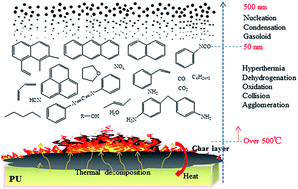Recent studies on the decomposition and strategies of smoke and toxicity suppression for polyurethane based materials
Abstract
The widespread application of polyurethane-based materials promotes its development and increases the requirement of flame retardancy and smoke toxicity properties. This review provides insight into recent studies related to thermal degradation, smoke and toxicity production for polyurethane-based materials. Factors influencing smoke production, smoke and toxicity suppression, mechanisms of polyurethane decomposition and its evaluation methods are summarized. Recent polyurethane smoke suppression strategies include the use of metal-based compounds (metal oxides, metal salts, metal–organic hybrids and metal hydroxides), melamine, carbon-based additives as well as other miscellaneous additives. The mechanism of action of these additives are also summarized in this review.


 Please wait while we load your content...
Please wait while we load your content...